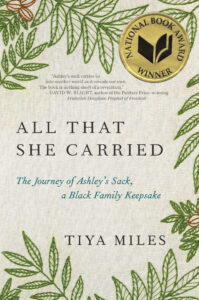SDA Book Club: “All That She Carried” reviewed by Faith Hagenhofer
February 3, 2023
All That She Carried by Tiya Miles

This book is all about a small cloth sack, where “she” in the title is not the maker, but becomes the carrier. As the book unfolds, we learn this sack carried not just past, tangible things, but it has become a means, a carrier of stories. All That She Carried is a material culture study at its finest. We are given the opportunity to look deeply and closely at a textile object, and see, through it, as if through a prism, multiple views of undeniable history- enslavement of African and African American people, the economies they were a part of as owned and unfree people, racism’s ugliness and brutality, Black women’s resilience and persistence, and long engagement with fabric—as well as the rich tracing of a specific family’s matrilineal and likely history.
The sack begins as a plain sack, sewn by unfree Rose, who is preparing a gift for her enslaved daughter, Ashley, who has been sold away. Author Tiya Miles emphasizes in many ways the mere phenomenon of this activity, that someone who was herself bought and sold as if she were an object, could consolidate the material and assert her humanity and love through the creation of an unlikely object. We learn that a later relative, Ashley’s great grand-daughter Ruth, has embroidered the sack with its provenance. There is some speculation throughout the book about the specifics in Rose’s, Ashley’s, and finally Ruth’s stories, but grounding the story in them serves to tell the larger history.
By writing on a textile, the embroiderer, Ruth, has “attached a special story to a precious object” (p.260), transforming it into an historical document, and entering it into the human collection of culturally significant textiles. Simultaneously, All That She Carried underscores human coexistence with and dependance on fabric both literally and metaphorically.
It is an awesome and moving journey we are invited to take, who’s end result is that this bag has survived to the present, by passing through the hands of many women. The sack has accrued its specialness by not only being saved and passed, but by having been embellished with embroidered text that tells its story. In telling the bag’s story, we are led to see so much more—the story of the women who passed it along and the accompanying history of enslavement. One object and the women who cared for it, therefore, tells the story of the 4 million unfree enslaved people in the American South and the racism that continues to bear on African American lives. While the historical tale comes to a close as Ashley’s sack becomes a museum object, it is clear that the historical themes are as yet unresolved.
–Faith Hagenhofer
- Publisher: Random House (buy it here)
- Date: June 2021
- ISBN: 978-1984854995
If you’ve read this book, leave a comment and let us know what you think!
Do you have a recommendation for a recent fiber-related book you think should be included in SDA’s Book Club? Email SDA’s Managing Editor, Lauren Sinner, to let her know!
